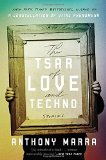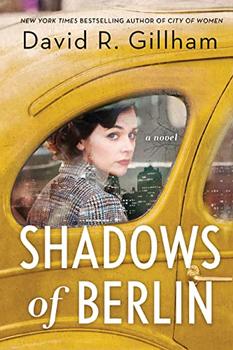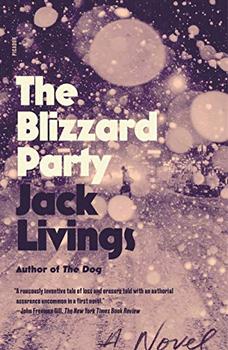Summary | Excerpt | Reviews | Beyond the book | Read-Alikes | Genres & Themes | Author Bio

Stories
by Anthony MarraAnthony Marra's debut novel, A Constellation of Vital Phenomena, is an excellent depiction of wartime Chechnya. By showcasing the survival of the human spirit and the enduring bonds of love, Marra proved that we are so much more than the physical signs of life referenced in the title. His second book – billed as short stories but as intricately constructed as a novel due to its recurring characters and interlocking storylines – returns to Eastern Europe, this time both Russia and Chechnya. Ranging from 1937 to 2013, the stories show how fear and propaganda linger in the post-Stalinist era.
In art as much as in politics, it can be difficult to distinguish airbrushed history from bitter reality. For instance, Roman Markin, the protagonist of the first story, "The Leopard," is a 1930s Russian government censor who spends his days touching up photos to make Stalin look younger or to remove unwanted figures like Trotsky and other enemies of the state. "History is the error we are forever correcting," he notes; "like one's politics, one's art is subordinate to the mandates of power." Those who break the rules face swift and severe punishment.
Like Roman, in "The Grozny Tourist Bureau," Ruslan Dokurov is charged with "improving" images, this time in the wake of the Chechen Wars. As the deputy director of the bombed-out Museum of Regional Art and the new head of tourism, he is tasked with tackling the place's reputation. The UN recently named it "most devastated city on earth," but as a good propagandist he is able to twist all the negatives into positives: "Upon seeing the empty space where an apartment block once stood, I wrote wide and unobstructed skies! I watched jubilantly as a pack of feral dogs chased a man, and wrote unexpected encounters with natural wildlife!"
However, Ruslan simply cannot find any appropriate scenes to photograph, so uses a nineteenth-century pastoral painting as illustration instead. This is Empty Pasture in Afternoon by Pyotr Zakharov-Chechenets (see 'Beyond the Book'), which will come to have a central role – not just the artwork, but also the field it depicts. Again and again, Marra returns to human artifacts that have unexpected significance: the Zakharov, Roman's doctored photographs, a mixtape a young man makes for his brother. Especially in an oppressive society, Marra seems to be saying, art is what lasts and what connects us.
Five of the stories have first-person narration, three are third-person, and one is in the intriguing first-person plural. Although they vary in time period and tone, the links between them are strong and surprising. The ballerina whom Roman reluctantly airbrushes from a photograph in the first story is the grandmother of Galina, the subject of the second story, "Granddaughters." Galina, later Miss Siberia, and an oligarch's wife, is the teenage sweetheart of Kolya, a central character in four of the nine stories. Kolya's brother Alexei, the humorous narrator of the title story, meets Ruslan when he sets off on a quest to find out what happened to Kolya during the Chechen War. Other characters are connected by the aforementioned artworks, or by family tragedies.
Family is indeed a central theme that plays out through unexpected inheritances, betrayals, and losses. Marra's characters sometimes have to choose between loyalty to the motherland and faithfulness to family. The book exposes the grim truth behind historical airbrushing, including labor camps and executions. Can the characters love their country even when it lets them down? Patriotism is a tall order unless you believe the propaganda. In the same way, even when relatives fail or denounce them, family remains paramount for these characters; the memory of love might be all that they have left.
Just as he did in his debut, Marra renders unspeakable tragedies bearable because of his warm and witty writing. All his characters' voices are well-realized and inviting, and he comes up with terrific one-liners. Especially in the title story, the text is dense with near-perfect sentences, ranging from funny to heartbreaking: "Hipsterdom's a tightrope strung across the canyon of douche-baggery;" "Turning I would to I did is the grammar of growing up;" and "She [Galina] had grown up in a city where history did not exist, where you kept secret what was real to prevent its erasure."
Wartime history and artistic expression are this book's twin poles, and for both of them Marra draws powerful contrasts between the airbrushed image and the reality it hides. In a seemingly vast and uncaring universe, human connections and creative freedom are what provide meaning. This is a rich set of stories that will reward repeat readings. It cements Marra's place among the best young writers in America today.
![]() This review was originally published in The BookBrowse Review in November 2015, and has been updated for the
August 2016 edition.
Click here to go to this issue.
This review was originally published in The BookBrowse Review in November 2015, and has been updated for the
August 2016 edition.
Click here to go to this issue.

If you liked The Tsar of Love and Techno, try these:

by David R. Gillham
Published 2023
A captivating novel of a Berlin girl on the run from the guilt of her past and the boy from Brooklyn who loves her.

by Jack Livings
Published 2022
A panoramic novel set in New York City during the catastrophic blizzard of February 1978.
When men are not regretting that life is so short, they are doing something to kill time.
Click Here to find out who said this, as well as discovering other famous literary quotes!
Your guide toexceptional books
BookBrowse seeks out and recommends the best in contemporary fiction and nonfiction—books that not only engage and entertain but also deepen our understanding of ourselves and the world around us.